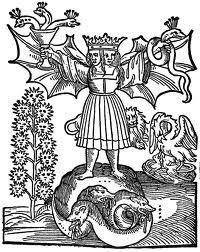Some time back I wrote an article for my college's journal of spirituality and religion about the magical moments woven into Disney movies. Many of these films incorporate subtle visual and lyrical references into their fast paced, universally acceptable plot, in a process which is know as twilight language. Twilight language (and no, we're not talking about team Edward here) has been used for centuries to conceal teachings of great depth beneath the superficial veneer of childrens' entertainment, often masking techniques used in real magic. But though twilight language pervades the works of Disney, Squaresoft, and many others, its impact did not start there, and nor will it end there.
The technology of twilight language has been used throughout history to disguise and disseminate philosophies which the masses would reject unveiled. Alchemists utilized twilight language extensively in their craft to avoid persecution, veiling their spiritual work in the material allegory of transforming base metals into gold. The great British occultist Elias Ashmole (1617-1692) described this subterfuge in his Theatricum Chemicum Britannicum. Of the alchemist’s usage of twilight language, Ashmole stated:
“Their chiefest study was to wrap their Secrets in Fables, and spin out their Fancies in Vailes and shadows, whose Radii seems to extend every way, yet so, they meet in a Common Center, and point only at One thing .”Elias Ashmole
For many, the holy texts themselves are seen as codicies concealing vast repositories of hidden truth, and their illumined writ bears profound grimores of practical magic. Noted occultist Manly P. Hall states that “it is essential” to the formation of any accurate history of spiritual thought to remember that “the early philosophers recognized in the Bible a book of chemical and alchemical formulae .” Using certain keywords and phrases as spiritual allegories, mystics throughout history have adapted sacred texts for formal, ‘magical’ purposes.
Manly P Hall, from around the time he wrote The Secret Teachings of All Ages
Likewise, the fairy tale is a perfect vessel for the conveyance of spiritual allegory. For as Rosicrucian scholar Percy Pigott claims, these “seemingly fanciful stories” are quite often used “to reveal hidden truths symbolized in the narrative .” The fairy tale is designed to appeal to children, a demographic known for its affinity for flights of fancy and perennially active imaginations. Many fairy tales have been handed down anonymously, passed through the ages by oral tradition.
As repositories for belief systems, fairy tales have survived the test of time because of their endearing, seemingly innocuous subject matter. In modern times notable intellects such as Goethe and Oscar Wilde both wrote children’s books, and Lewis Caroll and L. Frank Baum utilized them to critique existing social orders. Scholars such as C.S. Lewis and J.R. Tolkien used children’s literature to spread mythology, with the former explicitly advocating Christian theology and the latter veiling its Christian subtext under layers of fantastical mythology.
Tolkein played a large role in converting Lewis to Christianity through the Christian writers’ group The Inklings, and the influence of Christian theology cannot be understated the works of either Tolkein or Lewis. Both fantasies wove Christian theology into their imaginary worlds, and both Narnia and Middle Earth were replete with explicitly calculated mysticism of a high order.
Such tales gain their lasting power through the use of time tested spiritual and religious archetypes, and have made a lasting impact on modern culture. Disney is quite familiar with the lasting appeal of such inspiring source material, and overwhelmingly, the distilled twilight wisdom of traditional fairy tales forms the primary basis of Walt Disney’s magical rise to domination of children’s animation in the Western world. Films such as Snow White, Pinocchio, Fantasia, The Little Mermaid, Beauty and the Beast, Aladdin, The Lion King, The Hunchback of Notre Dame, and many others employ this technique to a potent degree in spinning their tales. In the posts to come I hope you will explore these depths with me as I delve into the twilight symbolism of the House of Mouse.





